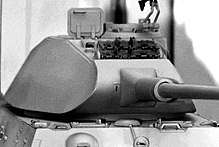Shot trap
A shot trap is a location on an armoured vehicle where, depending on the angle of impact, an impacting shell that fails to penetrate may bounce off in such a manner that it hits another area of the vehicle where it is more likely to cause damage to the vehicle and/or injure its crew. Areas on the vehicle where the described phenomenon can occur may be referred to as shot traps, and should obviously be redesigned.[1]
For example, initial turret design of the Panther and Tiger II tanks had a curved gun mantlet and a curved turret front plate respectively, both with a thickness of 100mm. The lower part of the armour plates acted as shot traps by deflecting incoming shots downwards towards the hull roof (16–17mm thick on the Panther, 40mm on the Tiger II), or into the turret ring where the shell could potentially jam the traverse mechanism. On the Panther a new flat "chin" on the mantlet solved the problem. The Tiger II production turret did not feature the curved front of the early turret, instead using a flat 180mm plate sloped back 10 degrees from the vertical.[2]
Notes
References

.jpg)